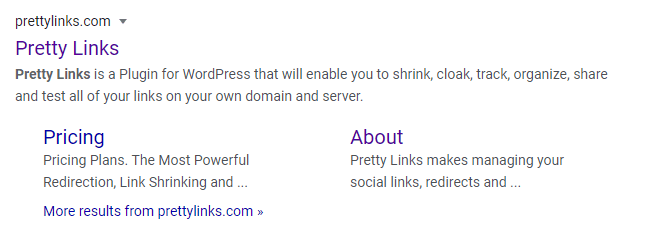Voici comment maîtriser la méta-description pour un meilleur référencement

Contenu
We need to get something about meta descriptions out of the way first and foremost: they do not matter to Google’s ranking system.
If there’s one thing you can count on from Google, it’s foggy and hidden information about what’s best for search engines. Meta descriptions are not exempt from the murkiness.
En fait, même la longueur autorisée des descriptions de recherche a augmenté et diminué au fil des ans (elle est passée à 320 caractères en décembre 2017, pour redescendre à 160 caractères en mai 2018). Suivre l'évolution de ces chiffres est une bataille frustrante mais nécessaire sur la voie d'un taux de clics (CTR) plus élevé.
You might wonder what the point of the rest of this post is, then. If Google doesn’t care about meta descriptions, why should you bother expertly crafting them? If your SEO efforts are unrewarded, why not skip them and head to the next optimization tactic?
Meta descriptions may not be part of Google’s ranking system, but they ARE a boon to your SEO strategy. They help improve the chance that a user will click through to your site, and at times they are la première et unique occasion qui se présente à vous.
In this blog post, we’re going to tell you why you should write meta descriptions, how you should write them, and what to remember to get the best CTR. Let’s get started!
Qu'est-ce qu'une méta-description ?

Let’s start by defining a meta description. According to Moz:
La méta-description est un attribut HTML qui fournit un bref résumé d'une page web. Les moteurs de recherche tels que Google affichent souvent la méta-description dans les résultats de recherche, ce qui peut influencer le taux de clics.
You’ve seen a meta description even if you don’t know what it is off the top of your head. It’s the excerpt that you find under the meta title in a search result.
It’s easy to see why these little descriptors are so important. They can be the only information a user has to decide whether they’ll click the link to your site or move on to someone else’s. In short, meta descriptions let the user know whether or not your page can solve their problem.
The interesting thing is that Google doesn’t always show your meta description. Research by Moz shows that custom meta descriptions are shown by Google only 51.3% of the time. This is due to several factors, including relevance, and is heavily dependent on the keywords used in the user’s search (more on that later).
Pourquoi une méta-description est-elle importante ?

Faut-il rédiger une méta-description ? Bien entendu. Le référencement consiste à combiner des tactiques pour stimuler votre site sur les moteurs de recherche, et les méta-descriptions sont une tactique trop facile pour être ignorée.
Consider these two-sentence-wonders your first-contact click-through bait. After you’ve input your search, the meta description is the first thing you’ll see on the SERP (if the engine has used your original one, of course).
Meta descriptions also matter because they’re often used by les réseaux sociaux pour présenter des informations lorsque vous créez un lien une page. Les omettre peut nuire à vos efforts de partage social.
Qu'est-ce qui fait les meilleures méta-descriptions ?
Meta descriptions should follow all of your copywriting rules of engagement: power words, verbs, and calls to action. If you ever watched a Vine back when they were a thing, you know that shorter doesn’t mean less powerful. Shorter can mean harder to execute, but a powerful punch when done right!
Vous voulez que votre description décrive la page avec précision à l'utilisateur, mais aussi qu'elle le convainque que la page résoudra son problème. Votre description doit soutenir ces objectifs.
Créer une méta-description magistrale :
- Concentrez-vous à condenser le point de votre message de la manière la plus précise (et la plus vibrante) possible.
- Utilisez des mots-clés pertinents (Google les met en gras dans la description).
- Use your brand’s usual voice
- Indiquer à l'utilisateur ce qu'il doit faire grâce à des appels à l'action directs
- Communiquer d'abord les informations les plus importantes
You get 160 characters to write out your masterpiece meta description, but do your best to do it in 155. That way your descriptions show up in full. Maintaining this length may not always be possible, and that’s okay! You can still help your descriptions show up if you:
- Évitez les doublons qui risquent d'être trop visibles dans les résultats de recherche.
- Utiliser des appels à l'action et des mots-clés pertinents
- Describe what’s actually in your content
- Utilisez vos verbes !
- Don’t use quotation marks (Google will cut off your description at the quotation)
- S'en tenir à moins de 155 mots dans la mesure du possible
- Utilisez les meilleures pratiques de rédaction - vous essayez de PERSUADER
Comment vous assurer que vos méta-descriptions apparaissent sur Google ?
It’s important to know how meta descriptions work to take advantage of them. Search engines are looking for specific keywords and phrases that a user types into the search. That means your description needs to include phrasing that matches your content enough to match a user’s search.
There are tools to make the process a lot easier. Using a plugin like All In One SEO helps you keep your meta descriptions unique, and it also helps to create and update them easily.
Conseil : utilisez un moteur de recherche de sites web tel que Grenouille hurlante pour trouver les pages ou les articles de blog dont les méta-descriptions sont manquantes. De cette façon, vous pouvez optimiser, optimiser, optimiser !
Conclusion
Vos méta-descriptions sont un élément simple et essentiel de votre stratégie de référencement. En maîtrisant ces merveilles de deux ou trois phrases, vous donnerez à votre site Web une plus grande visibilité. moteur de recherche L'optimisation de l'énergie nucléaire est un atout considérable, et tout le monde a besoin d'aide à cet égard de nos jours.
Keep our strategies in mind, and you’ll be writing meta description masterpieces in no time!
Remplissez-vous votre méta-descriptions sur chaque article ? Faites-nous part de votre stratégie dans les commentaires !